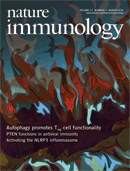Advanced Search
Reconstruction of the Mouse Inflammasome System in HEK293T Cells
Published: Vol 6, Iss 21, Nov 5, 2016 DOI: 10.21769/BioProtoc.1986 Views: 11453
Edited by: Ivan Zanoni Reviewed by: Meenal Sinha
Abstract
The NLRP3 (NLR family, Pyrin domain containing 3) inflammasome is a multiprotein complex comprised of NLRP3, pro-caspase-1, the adaptor protein apoptosis-associated speck-like protein containing a CARD (ASC), and the protein kinase NIMA related kinase 7 (NEK7) (Shi et al., 2016; He et al., 2016; Schmid-Burgk et al., 2016). When cells are exposed to microbes and/or danger signals, the inflammasome assembles and serves as a platform for the activation of caspase-1. Caspase-1 activation promotes the processing and secretion of the pro-inflammatory cytokines interleukin-1β (IL-1β), IL-18, and IL-33 as well as pyroptosis induction (Gross et al., 2011; Arend et al., 2008), which elicit inflammatory responses. Here, we describe how to co-transfect the NLRP3 inflammasome components into HEK293T cells, which enables inflammasome activation and the production of IL-1β upon stimulation with nigericin.
Background
Inflammasomes are multiprotein complexes that control inflammatory responses and coordinate immune responses against invading microbes. Reconstitution of the NLRP3 inflammasome in vitro provides an easy and efficient way to study the regulation of inflammasome activation. In this protocol, NEK7 was introduced into the in vitro NLRP3 inflammasome system and the ratio among the NLRP3 inflammasome components was optimized, making the reconstituted NLRP3 inflammasome more similar to the physiological inflammasome in vivo. Nigericin was used to activate the inflammasome as we have observed that it induces a rapid rate of IL-1β secretion compared to other inflammasome activators. Using this protocol, the levels of IL-1β can be assayed to determine NLRP3 inflammasome function under physiological conditions as well as after gene knockdown or overexpression.
Materials and Reagents
- Costar 24 well clear TC-treated multiple well plate (Corning, Costar®, catalog number: 3527 )
- 1.5 ml Eppendorf tubes
- HEK293T cells (ATCC, catalog number: CRL-11268 )
- Dulbecco’s modified Eagle medium (DMEM) (Thermo Fisher Scientific, GibcoTM, catalog number: 10569-044 )
- Fetal bovine serum (FBS) (Gemini Bio-Products, catalog number: 100-106 )
- Penicillin-streptomycin (10,000 U/ml; 10,000 μg/ml) (Thermo Fisher Scientific, GibcoTM, catalog number: 15140-163 )
- Pro-IL-1β-Flag, NLRP3-Flag, ASC1-Flag, pro-caspase-1-Flag and NEK7-HA plasmids
Note: Pro-IL-1β, NLRP3, ASC1, pro-caspase-1, and NEK7 were amplified by standard PCR techniques and were subsequently inserted into mammalian expression vectors using the In-Fusion® HD cloning kit per manufacturer’s instructions (click here for a detailed protocol and Shi et al., 2016). All plasmids were submitted to Addgene.
pCMV-pro-IL1β-C-Flag (Addgene, catalog number: 75131 )
pcDNA3-N-Flag-NLRP3 (Addgene, catalog number: 75127 )
pcDNA3-N-Flag-ASC1 (Addgene, catalog number: 75134 )
pcDNA3-N-Flag-Caspase-1 (Addgene, catalog number: 75128 )
pcDNA3-N-HA-NEK7 (Addgene, catalog number: 75142 ) - IL-1β ELISA Kit (affymetrix ,eBioscience, catalog number: 88-7013-76 )
- Plasmid Plus Midi Kit (QIAGEN, catalog number: 12943 )
- LB medium (MP Bio, catalog number: 3002-31 )
- Opti-MEM® (Thermo Fisher Scientific, GibcoTM, catalog number: 51985-034 )
- Lipofectamine® 2000 transfection reagent (Thermo Fisher Scientific, InvitrogenTM, catalog number: 11668-019 )
- Nigericin (Sigma-Aldrich, catalog number: N7143-10MG )
- Ethanol
- SuperSignalTM West Pico chemiluminescent substrate (Thermo Fisher Scientific)
- DMEM cell culture medium (see Recipes)
- Nigericin stock solution (see Recipes)
Equipment
- 37 °C, 5% CO2 forced-air incubator (Thermo Fisher Scientific, Fisher Scientific, model: Sanyo Incubator Panasonic MCO-19AIC(UV) CO2 )
- Shaker incubator (Eppendorf, model: New Brunswick I24 )
- Pipettes (Mettler-Toledo, ShopRainin)
- Microcentrifuge (Eppendorf, model: Centrifuge 5424 )
- ELISA plate reader (Bio Tek Instruments, model: Synergy Neo2 Multi-Mode Reader )
- Spectrophotometer (Thermo Fisher Scientific, Thermo ScientificTM, model: NanoDrop 2000c Spectrophotometer )
Software
- GraphPad Prism 6 software (http://www.graphpad.com/scientific-software/prism/)
Procedure
Category
Immunology > Immune cell function > General
Molecular Biology > DNA > Transfection
Do you have any questions about this protocol?
Post your question to gather feedback from the community. We will also invite the authors of this article to respond.
Share
Bluesky
X
Copy link


